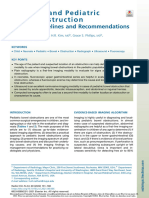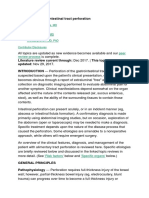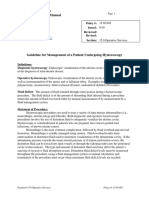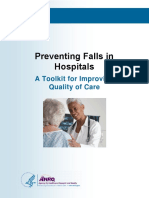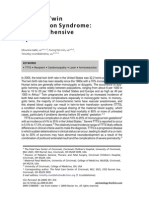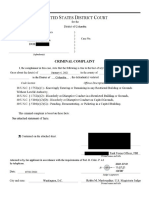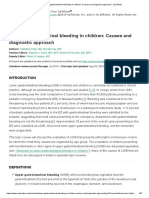Pathogenic Escherichia Coli
Pathogenic Escherichia Coli
Uploaded by
Mai HunnyCopyright:
Available Formats
Pathogenic Escherichia Coli
Pathogenic Escherichia Coli
Uploaded by
Mai HunnyOriginal Description:
Copyright
Available Formats
Share this document
Did you find this document useful?
Is this content inappropriate?
Copyright:
Available Formats
Pathogenic Escherichia Coli
Pathogenic Escherichia Coli
Uploaded by
Mai HunnyCopyright:
Available Formats
7/22/2015
PathogenicEscherichiacoli
OfficialreprintfromUpToDate
www.uptodate.com2015UpToDate
PathogenicEscherichiacoli
Author
Christine
A
Wanke,
MD
Section
Editor
Stephen
B
Calderwo
od,MD
Deputy
Editor
Allyson
Bloom,
MD
Disclosures:ChristineAWanke,MDConsultant/AdvisoryBoards:Cubist[DSMB].OtherFinancialInterest:ParrPharmaceuticals
[Expertwitnessinpatentcase(Megestrolacetate)].StephenBCalderwood,MDPatentHolder:VaccineTechnologiesInc.
[Vaccines(Choleravaccines)].EquityOwnership/StockOptions:Pulmatrix[Inhaledantimicrobials]PharmAthene[Anthrax(Anti
protectiveantigenmonoclonalantibody)].AllysonBloom,MDNothingtodisclose.
Alltopicsareupdatedasnewevidencebecomesavailableandourpeerreviewprocessiscomplete.
Literaturereviewcurrentthrough:Jun2015.|Thistopiclastupdated:Oct15,2013.
INTRODUCTIONEscherichiacoliarenormalinhabitantsofthehumangastrointestinaltractandareamongthe
bacterialspeciesmostfrequentlyisolatedfromstoolcultures.WhenE.colistrainsacquirecertaingenetic
material,theycanbecomepathogenic.E.coliareamongthemostfrequentbacterialcausesofdiarrheaandare
classifiedbyclinicalsyndrometheyproduce(table1)[1].
ThecharacteristicsofdiarrhealillnesscausedbyenterotoxigenicE.coli(ETEC),enteropathogenicE.coli(EPEC),
enterohemorrhagicE.coli(EHEC,alsocalledShigatoxinproducingE.coliorSTEC),enteroinvasiveE.coli
(EIEC),andenteroaggregativeE.coli(EAECorEAggEc)willbereviewedhere.EHECisalsodiscussedin
greaterdetailseparately.(See"Microbiology,pathogenesis,epidemiology,andpreventionofenterohemorrhagic
Escherichiacoli(EHEC)"and"Clinicalmanifestations,diagnosisandtreatmentofenterohemorrhagicEscherichia
coli(EHEC)infection".)
MICROBIOLOGYE.colicanbeculturedreadilyfromthestoolunderaerobicconditions.Onselectivemedia,
suchasMacConkeyagar,E.coliusuallyappearaspinkcolonies,indicatingthattheorganismfermentslactose
(picture1).Additionalbiochemicalidentificationshouldalsobeperformed,sinceupto10percentofE.colidonot
fermentlactoseorfermentlactoserelativelyslowly.ThemostusefulbiochemicalidentificationtestforE.coliis
theindoletest,whichispositiveinupto99percentofE.colistrains.
PathogenicE.coliarenotdistinguishablefromotherstrainsorfromeachotherbytheappearanceonculture
platesorbytheresultsoftheusualbiochemicaltests.Todeterminewhethertheisolatedstrainisoneofthe
pathogenicstrainsormerelyaconstituentofthenormalflora,additionalidentificationtechniquesmustbe
employed,whicharegenerallylimitedtoresearchlaboratorysettings.
EHECO157istheonlypathogenicstrainthatcanbeidentifiedreadilyintheclinicallaboratory[2].Furthertesting
onpathogenicE.coliisolatesmustbeperformedinaresearchorreferencelaboratory.Thistestingcaninclude
determiningtheserotypeofthestrain,performingbiologicalassays(bioassays)thatdemonstratestrainvirulence,
andusinggenetictools,suchasDNAprobingorpolymerasechainreaction(PCR)amplification,toidentify
geneticmaterialthatencodesforspecificvirulencefactors.
ThevirulencetraitsaredistinctforeachcategoryofpathogenicE.coli[3].Thesevirulencetraitsinclude
adherencefactorsthatallowE.colitoattachtotheintestinalmucosa,andtoxinsthatinterruptnormalintestinal
cellsecretionandabsorption(secretorytoxins)orthatdamagetheintestinalcell(cytotoxins).Theseadherence
factorsandtoxinsareencodedonaccessorygeneticelementsinE.coli,suchasplasmids,transposons,and
bacteriophages.
ENTEROTOXIGENICESCHERICHIACOLI(ETEC)EnterotoxigenicE.coli(ETEC)causeswaterydiarrheain
http://www.uptodate.com/contents/pathogenicescherichiacoli?source=search_result&search=Escherichia+coli&selectedTitle=1%7E150
1/9
7/22/2015
PathogenicEscherichiacoli
younghumansandothermammals,aswellasinolderindividualswhohavenotbeenexposedtotheorganism[4].
ETECsurvivereadilyinwaterandfoodsuppliesinthedevelopingworldandisoneofthemostcommonbacterial
causesofdehydratingdiarrhealillnessinchildrenundertwoyearsofageintheseregions[5].Thesestrainscan
alsocausediarrheaintravelerstotropicalregionswhoareexposedtocontaminatedfoodandwater.Inaddition,
ETECisemergingasasignificantdiarrhealpathogenindevelopedregions[68].(See"Travelers'diarrhea:
Microbiology,epidemiology,andprevention".)
PathogenesisThepathogenesisofdiseaseduetoETECconsistsoftransmissionofbacteria,intestinal
colonization,andelaborationofvirulencefactor(s).ETECmustcontaincolonizingfimbriaetopermitthe
attachmentofthebacteriatotheintestine.Antibodiestofimbrialadhesins,specificallycolonizationfactorantigen
I,havebeenshowntobeprotectiveinamousemodel[9].
E.colicapableofattachingtotheintestinemustalsobecapableofelaboratingvirulencefactorsinordertocause
disease.TherearetwomajorclassesofsecretorytoxinsencodedonplasmidsinETECstrains:heatlabiletoxins
(LT)andheatstabletoxins(ST)[10].E.colithatcontainoneorbothofthesetoxinclassesareclassifiedas
ETEC[11].
LTisacomplexfamilyoftoxinsrelatedtocholeratoxinproducedbyVibriocholeraewithrespecttostructure,
functionandmechanism.LTactsbystimulatingadenylatecyclaseandincreasingintracellularcyclicAMP,which
resultsinsecretionofchloridefromintestinalcryptcellsandinhibitionofabsorptionofsodiumchlorideatthevillus
tips.Secretionoffreewaterintotheintestinallumenfollows,manifestingclinicallyaswaterydiarrhea[12].Studies
suggestthatLTanditssecretionapparatuscanclusteratoneendofthebacterialorganism,whichmaypermit
ETECtofocustoxindeliverytothehostintestinalcell[13].(See"PathogenesisofVibriocholeraeinfection".)
TherearetwomajorSTsthatmaybepresentinETEConlyoneofthese,STa,isassociatedwithhuman
disease.STactivatesenterocytecyclicGMPandalsoleadstothestimulationofchloridesecretionandinhibition
ofsodiumchlorideabsorption.Theendresultissecretionoffreewaterintotheintestinallumen,whichmanifests
clinicallyaswaterydiarrhea[12].
Approximately10(8)to10(10)ETECmustbeingestedtoinducediarrheainanotherwisehealthyindividual[1].
Exposuretothislargeinoculumoccursreadilysincethepathogenthrivesintheenvironment.Theillnesshasa
shortincubationperiod,andtheonsetofsymptomsandsignsisrapid.Patientsmayreportnausea,butvomitingis
uncommon.Diarrheaiswateryandmaybemildorsevere.Theillnessmaylastforonetofivedays.
DiagnosisandtreatmentThediagnosisofETECiscurrentlyperformedintheresearchorreferencelaboratory
usingDNAprobesthatidentifythegenesforLTorST[14,15].Classicallytheseorganismswereidentifiedby
bioassaysforthesecretorytoxins:therabbitilealloopforLTandthesucklingmouseassayforST.
TreatmentofdiarrhealillnessduetoETECisdiscussedindetailseparately.(See"Travelers'diarrhea:Clinical
manifestations,diagnosis,andtreatment".)
ENTEROPATHOGENICESCHERICHIACOLI(EPEC)EnteropathogenicE.coli(EPEC)strainsaredefined
bythecharacteristic"attachingandeffacing"effecttheyelicituponinteractionwithepithelialcellsandbythefact
thattheydonotproduceShigatoxin(figure1).EPEChavebeenassociatedwithsporadicdiarrhealillnessand
diarrheaoutbreaks,mostcommonlyamongchildrenlessthansixmonthsofageindevelopingcountries[16].
DiseaseduetoEPECstrainshasbeendescribedamongadults,althoughovertillnessismuchlesscommon.
ThisistrueevenamongadultsinthedevelopingworldwhofrequentlydevelopdiarrheaduetoETEC[17].
PathogenesisEPECproteinsdonotbehavelikeclassictoxinsthefollowingobservationshavefurtheredour
understandingofhowbacterialorganismscanaffectcellphysiologythroughadherence,evenintheabsenceof
toxinproduction.ThestepsinpathogenesisofEPECforinitiationofdiarrhealillnessinclude[1821]:
Initiallocalizedadherenceoftheorganismstotheenterocyte
InductionofsignaltransductionintheenterocytebyEPECproteinsecretion
http://www.uptodate.com/contents/pathogenicescherichiacoli?source=search_result&search=Escherichia+coli&selectedTitle=1%7E150
2/9
7/22/2015
PathogenicEscherichiacoli
Developmentofintimateadherencewiththeenterocyte
Signaltransductionisinitiatedbybacterialsecretionofproteinsdirectlyintotheenterocyte[22].Thiscauses
mobilizationofintracellularcalcium,activationofproteinkinaseCandthemyosinlightchainkinase,andinduction
oftyrosinephosphorylationofproteins[23].Activationofthesesignaltransductionpathwaysproduceschangesin
theenterocyte(resultingintheclassic"attachingandeffacing"lesion),alterationsinwaterandelectrolyte
secretion,andincreasedpermeabilityofintestinaltightjunctions.Thegenesthatencodethesevirulencetraitsare
locatedonaplasmid(bundleformingpili)orwithinachromosomalpathogenicityislandoftheorganism.Atypical
EPECdonotproducebundleformingpili.
EspFisasecretedproteinthatisnotinvolvedwithattachingandeffacingitappearstodisruptintestinalbarrier
functionbyincreasingmonolayerpermeabilityviaalterationofelectricalresistance[24].EspFhasseveralprotein
proteininteractiondomainsthatmayfunctionbyinteractingwithendocyticregulation[25].Twoothersecreted
proteins,EspGandEspG2,inhibitluminalmembranechlorideabsorptionbydecreasingsurfaceexpressionofthe
Cl/OHexchangerviadisruptionofmicrotubules[26].
ThediarrheaassociatedwithEPECinchildrencanbesevere,withconcomitantvomitinganddehydration.If
diarrheapersists,malnutritioncanbeadevastatingcomplication,particularlyinthedevelopingworldwhere
resourcesforsupportivetherapymaybelimited.CellculturedatasuggestthatEPECinfectioninhibitsabsorption
ofthiaminethismaybeonemechanismbywhichEPECinfectioncontributestomalnutritionofsome
micronutrients[27].
DiagnosisandtreatmentThegoldstandardforidentificationofEPECisthedetectionbyDNAprobeor
polymerasechainreaction(PCR)oftheEPECadherencefactor(EAF).Thesediagnosticassaysareavailable
onlyinresearchorreferencelaboratories.
EPECwasoriginallycategorizedandrecognizedbyserotypeandlater,byitsabilitytoadhereinalocalized
fashiontoepithelialcellsinatissuecultureadherenceassay[28,29].Subsequently,itwasidentifiedbyitsability
tomobilizecellularactininafluorescentactinstaining(FAS)assay[30].Usingtheseoldertechniques,the
absenceofEHECtoxinsalsohadtobedemonstratedinaputativeEPECorganismbecausesomestrainsof
EHECalsodevelopattachingandeffacinglesions.
TreatmentofdiarrhealillnessduetoEPECisdiscussedindetailseparately(See"Approachtothechildwithacute
diarrheainresourcelimitedcountries",sectionon'Treatment'.)
ENTEROHEMORRHAGICESCHERICHIACOLI(EHEC)EnterohemorrhagicE.coli(EHEC)strainsare
capableofproducingShigatoxinandlikeEPECstrains,demonstratean"attachingandeffacing"lesion(figure1).
AsubsetofEHECorganismsareserotypeO157:H7[2,31].InMay2011,anewShigatoxinproducingEHEC
similartoEAEC55989wasidentifiedasthecauseofanoutbreakinGermanyandinothercountriesinEurope
[32,33].Thisstrain,O104:H4,hasthetypicalplasmidadherencegenesofEAECbacteriaaswellasShigatoxin
genesseeninEHEC,andhasdemonstratedaggressivevirulence[34,35].(See"Clinicalmanifestations,diagnosis
andtreatmentofenterohemorrhagicEscherichiacoli(EHEC)infection".)
TherearealsoShigatoxinnegativeO157strainsinareviewofO157isolatesfromstoolspecimensrelatedto
sporadiccasesofdiarrhea,4percentwereShigatoxinnegative[36].ThesestrainswereeitherinherentlyShiga
toxinnegativeanddidnotcausebloodydiarrheaorHUSorweredescendedfromEHECstrainsbythelossof
Shigatoxingenes.ThesestrainsmaystillcauseHUS[36,37].
EHECstrains,especiallythosebelongingtoserotypeO157:H7,havebeenresponsibleforlargeoutbreaksof
bloodydiarrhea,someassociatedwithhemolyticuremicsyndrome(HUS),atriadofmicroangiopathicanemia,
renalfailure,andthrombocytopenia[38,39].
EHECinfectionisdiscussedfurtherseparately.(See"Microbiology,pathogenesis,epidemiology,andprevention
ofenterohemorrhagicEscherichiacoli(EHEC)"and"Clinicalmanifestations,diagnosisandtreatmentof
enterohemorrhagicEscherichiacoli(EHEC)infection".)
http://www.uptodate.com/contents/pathogenicescherichiacoli?source=search_result&search=Escherichia+coli&selectedTitle=1%7E150
3/9
7/22/2015
PathogenicEscherichiacoli
Shigatoxinassociatedhemolyticuremicsyndromeisdiscussedfurtherseparately.(See"Clinicalmanifestations
anddiagnosisofShigatoxinproducingEscherichiacoli(STEC)hemolyticuremicsyndrome(HUS)inchildren"and
"TreatmentandprognosisofShigatoxinproducingEscherichiacoli(STEC)hemolyticuremicsyndrome(HUS)in
children".)
ENTEROINVASIVEESCHERICHIACOLI(EIEC)EnteroinvasiveE.coli(EIEC)iscloselyrelatedtoShigella
andcausesdiseasethatissimilartoshigellosis.EIECinvadestheintestinalcell,multipliesintracellularly,and
extendsintotheadjacentintestinalcells.ThesamegenesfacilitatepathogenesisofbothEIECandShigella[40].
EIECmaybedifferentiatedfromShigellaprincipallybythefactthatEIECstrainsfermentglucoseandxylose.
(See"Shigellainfection:Epidemiology,microbiology,andpathogenesis".)
ClinicalEIECinfectionappearstobeuncommon,althoughitmaybeunderdiagnosed.ClinicaldiseasewithEIEC
beginsaswaterydiarrheaandmayormaynotproceedtobloodydiarrhea.Theorganismscanbedetectedby
DNAprobe,althoughthistoolisnotroutinelyavailableinclinicallaboratories.
TheclinicalapproachisasoutlinedseparatelyforShigellainfection.(See"Shigellainfection:Treatmentand
preventioninadults".)
ENTEROAGGREGATIVEESCHERICHIACOLI(EAEC)EnteroaggregativeE.coli(EAECorEAggEc)was
firstdescribedinthe1980s,whencollectionsofE.colifromstudiesofdiarrheainthedevelopingworldwere
examinedintissuecultureadherenceassays[41].E.colithathadadistinctivecascadingadherenceonHep2
cellswereobservedmorefrequentlyinthestoolsofchildrenwithdiarrheathanchildrenwithoutdiarrhea[42].
TherehasbeenaconsistentassociationbetweenpersistentdiarrheaamongchildrenandthepresenceofEAECin
thestoolinstudiesfromChile,Brazil,Mexico,India,andBangladesh[4349].
EAECappearstobeacauseofacutediarrhealillnessamongmanydifferentsubpopulationsinbothdeveloping
andindustrializedregions.SurveysofE.colifromdiarrheaoutbreaksinEuropehavedemonstratedthepresence
ofEAECinbothoutbreaksandsporadiccasesofdiarrhea[50,51].EAEChavealsobeenassociatedwith
persistentdiarrheainadultswithHIVinfectionintheUnitedStatesandSwitzerland[52,53].Inthesestudies,
EAECdiarrheawasmorecommoninpatientswithadvancedimmunecompromise.
InaUSprospectivestudyofdiarrhealillnessamongpatientsandcontrols,EAECwasobservedin4.5percentof
casesandoccurredsignificantlymorefrequentlyamongcasesthancontrolstherewasnoassociationwithtravel
orimmunodeficiency[54].AmetaanalysisnotedapositivecorrelationbetweenacutediarrhealillnessandEAEC
excretioninthefollowinggroups[55]:
Childrenresidinginbothdevelopingandindustrializedregions
AdultswithHIVinfectionresidingindevelopingregions
Adultsresidingindevelopingregions
Internationaltravelerstodevelopingregions
PathogenesisThepathogenesisofdiarrheacausedbyEAECisnotwellunderstood[42].EAECarecapableof
inducingthereleaseofinterleukin(IL)8fromCaco2humancolonicepithelialcells[56].Investigatorshavecloned
andsequencedasolublefactorfromEAECresponsibleforIL8releaseandidentifiedittobeanovelflagellin[57].
StrainsofEAECthatlackthisflagellindonotpromoteIL8release,whichmaybeimplicatedintheinductionof
chronicintestinalinflammation.
Avarietyofotherpathogeneticmechanismshavebeenpostulated:
Adherencefimbriae(AAF/1AAF/III)havebeenidentified,butthemajorityofEAECstrainsdonotexpress
theseadherencefactors[58].Thegenesforthesefimbriaeareencodedinavirulenceplasmidthatappears
tobepresentinmostEAECstrainsregardlessofwhetherornotAAF/IorAAF/IIisexpressed.TheaggR
geneencodesaproteinlabeleddispersin,whichactstodispersethebacteriaonthecolonicmucosa[59].
Mucosaldestructionhasbeendemonstratedinclinicalspecimensandintissuecultureassays,anda
http://www.uptodate.com/contents/pathogenicescherichiacoli?source=search_result&search=Escherichia+coli&selectedTitle=1%7E150
4/9
7/22/2015
PathogenicEscherichiacoli
cytotoxinhasbeenidentifiedinEAECstrains.
OthergroupshaveidentifiedEAECstrainsthatinvadetissueculturecellsandinduceIL8productionvia
mitogenactivatedproteinkinase[60,61].
A"package"ofplasmidborneandchromosomallymediatedvirulencefactorsisthoughttobepredictiveof
pathogenesis.Itispostulatedthatthis"package"isunderthecontrolofatranscriptionalactivatorcalledAggR
[62].ThesevirulencefactorsappeartobeassociatedwiththepresenceofdiarrheainindividualswithEAEC
strainsinthestool[63].AnewlyidentifiedHdaAgeneclusteralsoappearstoconferaggregativeadherenceand
mayexplaintheaggregativeadherencethathasnotbeenassociatedwiththeotherrecognizedadhesins[64].
DiagnosisandtreatmentThegoldstandardforthediagnosisofEAECisthetissuecultureadherenceassay.
ThereisnoDNAprobethatreliablyidentifiesEAECstrainsthus,EAECcanonlybediagnosedinresearchor
referencelaboratories[1].
SeveralstudieshavedemonstratedthatdiarrhearesolvedwhenEAECwasclearedfromthestoolwithantibiotic
treatment[65,66].Inaplacebocontrolledtrialincluding29patientswithEAEC,treatmentwithciprofloxacin
reducedthedurationofdiarrheacomparedtoplacebo(35versus56hours)[65].Inacrossovertrialof24HIV
infectedpatientswithEAEC,treatmentwithciprofloxacineradicatedtheorganismfromstoolandreduceddaily
stooloutputby50percent[66].
SinceidentificationofEAECrequiresreferencelaboratorytools,patientswithsuspectedEAECinfectioninthe
absenceofdiagnosticconfirmationshouldbemanagedsyndromicallyasdiscussedindetailseparately.(See
"Approachtotheadultwithacutediarrheainresourcerichcountries"and"Approachtotheadultwithacute
diarrheainresourcelimitedcountries"and"Approachtothechildwithacutediarrheainresourcelimitedcountries"
and"Evaluationofdiarrheainchildren".)
OTHERESCHERICHIACOLISTRAINSTherearenogooddatasupportingtheassociationofothertypesof
E.coli(eg,diffuselyadherentE.coli,detachingE.coli)withdiarrhea.However,sinceE.coliareubiquitousand
haveademonstratedcapacityforacquiringtheDNAforvirulencetraitsfromotherorganisms,additionalgroupsof
E.coliwillprobablybeassociatedwithdiarrhealdiseaseinthefuture.
INFORMATIONFORPATIENTSUpToDateofferstwotypesofpatienteducationmaterials,"TheBasics"and
"BeyondtheBasics."TheBasicspatienteducationpiecesarewritteninplainlanguage,atthe5thto6thgrade
readinglevel,andtheyanswerthefourorfivekeyquestionsapatientmighthaveaboutagivencondition.These
articlesarebestforpatientswhowantageneraloverviewandwhoprefershort,easytoreadmaterials.Beyond
theBasicspatienteducationpiecesarelonger,moresophisticated,andmoredetailed.Thesearticlesarewritten
atthe10thto12thgradereadinglevelandarebestforpatientswhowantindepthinformationandarecomfortable
withsomemedicaljargon.
Herearethepatienteducationarticlesthatarerelevanttothistopic.Weencourageyoutoprintoremailthese
topicstoyourpatients.(Youcanalsolocatepatienteducationarticlesonavarietyofsubjectsbysearchingon
"patientinfo"andthekeyword(s)ofinterest.)
Basicstopics(see"Patientinformation:Travelersdiarrhea(TheBasics)"and"Patientinformation:E.coli
(TheBasics)")
SUMMARY
Escherichiacoliarenormalinhabitantsofthehumangastrointestinaltractandareamongthebacterial
speciesmostfrequentlyisolatedfromstoolcultures.WhenE.colistrainsacquirecertaingeneticmaterial,
theycanbecomepathogenic.E.coliareamongthemostfrequentbacterialcausesofdiarrheaandare
classifiedbyclinicalsyndrometheyproduce(table1).(See'Introduction'above.)
http://www.uptodate.com/contents/pathogenicescherichiacoli?source=search_result&search=Escherichia+coli&selectedTitle=1%7E150
5/9
7/22/2015
PathogenicEscherichiacoli
E.colicanbeculturedreadilyfromthestoolunderaerobicconditions.PathogenicE.coliarenot
distinguishablefromotherstrainsorfromeachotherbytheirappearanceoncultureplatesorbytheresults
oftheusualbiochemicaltests.Todistinguishpathogenicstrainsfromnormalflora,additionalidentification
techniquesmustbeemployedinaresearchorreferencelaboratory.EHECO157istheonlypathogenic
strainthatcanbeidentifiedreadilyintheclinicallaboratory.(See'Microbiology'above.)
EnterotoxigenicE.coli(ETEC)causeswaterydiarrhea.ETECsurvivesreadilyinwaterandfoodandisone
ofthemostcommonbacterialcausesofdehydratingdiarrhealillnessinchildrenundertwoyearsofagein
developingregions.ETECcanalsocausediarrheaamongtravelerstotropicalregionswhoareexposedto
contaminatedfoodandwaterand,inaddition,isemergingasapathogenindevelopedregions.Thereare
twomajorclassesofsecretorytoxinsencodedonplasmidsinETECstrains:heatlabiletoxins(LT)and
heatstabletoxins(ST).ThesetoxinsactivatecyclicAMPorGMPrespectively,leadingtostimulationof
chloridesecretion,inhibitionofsodiumchlorideabsorption,andsecretionoffreewaterintotheintestinal
lumen,manifestingaswaterydiarrhea.(See'EnterotoxigenicEscherichiacoli(ETEC)'above.)
EnteropathogenicE.coli(EPEC)strainsaredefinedbythecharacteristic"attachingandeffacing"effect
theyelicituponinteractionwithepithelialcellsandbythefactthattheydonotproduceShigatoxin.EPEC
havebeenassociatedwithsporadicdiarrhealillnessanddiarrheaoutbreaks,mostcommonlyamong
childrenlessthansixmonthsofageindevelopingcountries.EPECproteinsdonotbehavelikeclassic
toxinsrather,theyaffectcellphysiologythroughadherenceandinductionofsignaltransduction.(See
'EnteropathogenicEscherichiacoli(EPEC)'above.)
EnterohemorrhagicE.coli(EHEC)strainsarecapableofproducingShigatoxinandlikeEPECstrains,
demonstratean"attachingandeffacing"lesion.AsubsetofEHECorganismsareserotypeO157:H7.
EHECstrains,especiallythosebelongingtoserotypesO157:H7(andsubsequently,O104:H4)havebeen
responsibleforlargeoutbreaksofbloodydiarrhea,someassociatedwithhemolyticuremicsyndrome.(See
'EnterohemorrhagicEscherichiacoli(EHEC)'aboveand"Clinicalmanifestations,diagnosisandtreatment
ofenterohemorrhagicEscherichiacoli(EHEC)infection".)
EnteroinvasiveE.coli(EIEC)iscloselyrelatedtoShigellaandcausesdiseasethatissimilartoshigellosis.
EIECinvadestheintestinalcell,multipliesintracellularly,andextendsintotheadjacentintestinalcells.The
samegenesfacilitatepathogenesisofbothEIECandShigella.ClinicaldiseasewithEIECbeginsas
waterydiarrheaandmayormaynotprogresstobloodydiarrhea.(See'EnteroinvasiveEscherichiacoli
(EIEC)'above.)
EnteroaggregativeE.coli(EAEC)wasfirstdescribedinthe1980s,whencollectionsofE.colifromstudies
ofdiarrheaindevelopingworldsettingswereexaminedintissuecultureadherenceassays.E.colithathad
adistinctivecascadingadherenceonHep2cellswereobservedmorefrequentlyinthestoolsofchildren
withdiarrheathanchildrenwithoutdiarrhea.EAECappearstobeacauseofpersistentandacutediarrheal
illnessamongmanydemographicgroupsinbothdevelopinganddevelopedregions.(See
'EnteroaggregativeEscherichiacoli(EAEC)'above.)
UseofUpToDateissubjecttotheSubscriptionandLicenseAgreement.
REFERENCES
1. NataroJP,KaperJB.DiarrheagenicEscherichiacoli.ClinMicrobiolRev199811:142.
2. MarchSB,RatnamS.SorbitolMacConkeymediumfordetectionofEscherichiacoliO157:H7associated
withhemorrhagiccolitis.JClinMicrobiol198623:869.
3. CasselsFJ,WolfMK.ColonizationfactorsofdiarrheagenicE.coliandtheirintestinalreceptors.JInd
Microbiol199515:214.
http://www.uptodate.com/contents/pathogenicescherichiacoli?source=search_result&search=Escherichia+coli&selectedTitle=1%7E150
6/9
7/22/2015
PathogenicEscherichiacoli
4. BlackRE,MersonMH,RoweB,etal.EnterotoxigenicEscherichiacolidiarrhoea:acquiredimmunityand
transmissioninanendemicarea.BullWorldHealthOrgan198159:263.
5. BlackRE,BrownKH,BeckerS,etal.Contaminationofweaningfoodsandtransmissionofenterotoxigenic
EscherichiacolidiarrhoeainchildreninruralBangladesh.TransRSocTropMedHyg198276:259.
6. BeattyME,AdcockPM,SmithSW,etal.EpidemicdiarrheaduetoenterotoxigenicEscherichiacoli.Clin
InfectDis200642:329.
7. DevasiaRA,JonesTF,WardJ,etal.Endemicallyacquiredfoodborneoutbreakofenterotoxinproducing
EscherichiacoliserotypeO169:H41.AmJMed2006119:168.e7.
8. YoderJS,CesarioS,PlotkinV,etal.OutbreakofenterotoxigenicEscherichiacoliinfectionwithan
unusuallylongdurationofillness.ClinInfectDis200642:1513.
9. AlvesAM,LsaroMO,PyrrhoAS,etal.AntibodyresponseinmiceimmunizedwithaplasmidDNA
encodingthecolonizationfactorantigenIofenterotoxigenicEscherichiacoli.FEMSImmunolMedMicrobiol
199923:321.
10. EvansDG,EvansDJJr,PierceNF.Differencesintheresponseofrabbitsmallintestinetoheatlabileand
heatstableenterotoxinsofEscherichiacoli.InfectImmun19737:873.
11. LevineMM,CaplanES,WatermanD,etal.DiarrheacausedbyEscherichiacolithatproduceonlyheat
stableenterotoxin.InfectImmun197717:78.
12. SearsCL,KaperJB.Entericbacterialtoxins:mechanismsofactionandlinkagetointestinalsecretion.
MicrobiolRev199660:167.
13. DorseyFC,FischerJF,FleckensteinJM.Directeddeliveryofheatlabileenterotoxinbyenterotoxigenic
Escherichiacoli.CellMicrobiol20068:1516.
14. MoseleySL,EcheverriaP,SeriwatanaJ,etal.IdentificationofenterotoxigenicEscherichiacolibycolony
hybridizationusingthreeenterotoxingeneprobes.JInfectDis1982145:863.
15. BegaudE,GermaniY.DetectionofenterotoxigenicEscherichiacoliinfaecalspecimensby
acetylaminofluorenelabelledDNAprobes.ResMicrobiol1992143:315.
16. RothbaumR,McAdamsAJ,GiannellaR,PartinJC.Aclinicopathologicstudyofenterocyteadherent
Escherichiacoli:acauseofprotracteddiarrheaininfants.Gastroenterology198283:441.
17. UlshenMH,RolloJL.Pathogenesisofescherichiacoligastroenteritisinmananothermechanism.NEnglJ
Med1980302:99.
18. DonnenbergMS,CalderwoodSB,DonohueRolfeA,etal.ConstructionandanalysisofTnphoAmutantsof
enteropathogenicEscherichiacoliunabletoinvadeHEp2cells.InfectImmun199058:1565.
19. DonnenbergMS,TziporiS,McKeeML,etal.TheroleoftheeaegeneofenterohemorrhagicEscherichiacoli
inintimateattachmentinvitroandinaporcinemodel.JClinInvest199392:1418.
20. DytocM,FedorkoL,ShermanPM.Signaltransductioninhumanepithelialcellsinfectedwithattachingand
effacingEscherichiacoliinvitro.Gastroenterology1994106:1150.
21. FinlayBB,RosenshineI,DonnenbergMS,KaperJB.Cytoskeletalcompositionofattachingandeffacing
lesionsassociatedwithenteropathogenicEscherichiacoliadherencetoHeLacells.InfectImmun1992
60:2541.
22. RabinowitzRP,LaiLC,JarvisK,etal.AttachingandeffacingofhostcellsbyenteropathogenicEscherichia
coliintheabsenceofdetectabletyrosinekinasemediatedsignaltransduction.MicrobPathog199621:157.
23. RosenshineI,DonnenbergMS,KaperJB,FinlayBB.Signaltransductionbetweenenteropathogenic
Escherichiacoli(EPEC)andepithelialcells:EPECinducestyrosinephosphorylationofhostcellproteinsto
initiatecytoskeletalrearrangementandbacterialuptake.EMBOJ199211:3551.
24. McNamaraBP,KoutsourisA,O'ConnellCB,etal.TranslocatedEspFproteinfromenteropathogenic
Escherichiacolidisruptshostintestinalbarrierfunction.JClinInvest2001107:621.
25. WeflenAW,AltoNM,HechtGA.TightjunctionsandenteropathogenicE.coli.AnnNYAcadSci2009
1165:169.
26. GillRK,BorthakurA,HodgesK,etal.MechanismunderlyinginhibitionofintestinalapicalCl/OHexchange
followinginfectionwithenteropathogenicE.coli.JClinInvest2007117:428.
27. AshokkumarB,KumarJS,HechtGA,SaidHM.EnteropathogenicEscherichiacoliinhibitsintestinalvitamin
B1(thiamin)uptake:studieswithhumanderivedintestinalepithelialCaco2cells.AmJPhysiolGastrointest
http://www.uptodate.com/contents/pathogenicescherichiacoli?source=search_result&search=Escherichia+coli&selectedTitle=1%7E150
7/9
7/22/2015
PathogenicEscherichiacoli
LiverPhysiol2009297:G825.
28. ScaletskyIC,SilvaML,TrabulsiLR.DistinctivepatternsofadherenceofenteropathogenicEscherichiacoli
toHeLacells.InfectImmun198445:534.
29. BaldiniMM,NataroJP,KaperJB.LocalizationofadeterminantforHEp2adherencebyenteropathogenic
Escherichiacoli.InfectImmun198652:334.
30. KnuttonS,BaldwinT,WilliamsPH,McNeishAS.Actinaccumulationatsitesofbacterialadhesiontotissue
culturecells:basisofanewdiagnostictestforenteropathogenicandenterohemorrhagicEscherichiacoli.
InfectImmun198957:1290.
31. JohnsonKE,ThorpeCM,SearsCL.TheemergingclinicalimportanceofnonO157Shigatoxinproducing
Escherichiacoli.ClinInfectDis200643:1587.
32. www.rki.de/EN/Home/homepage__node.html(AccessedonJune02,2011).
33. www.cdc.gov/media/releases/2011/s0601_ecoligermany.html?s_cid=2011_s0601_ecoligermany(Accessed
onJune02,2011).
34. RaskoDA,WebsterDR,SahlJW,etal.OriginsoftheE.colistraincausinganoutbreakofhemolytic
uremicsyndromeinGermany.NEnglJMed2011365:709.
35. RohdeH,QinJ,CuiY,etal.OpensourcegenomicanalysisofShigatoxinproducingE.coliO104:H4.N
EnglJMed2011365:718.
36. FriedrichAW,ZhangW,BielaszewskaM,etal.Prevalence,virulenceprofiles,andclinicalsignificanceof
ShigatoxinnegativevariantsofenterohemorrhagicEscherichiacoliO157infectioninhumans.ClinInfect
Dis200745:39.
37. MellmannA,BielaszewskaM,ZimmerhacklLB,etal.EnterohemorrhagicEscherichiacoliinhuman
infection:invivoevolutionofabacterialpathogen.ClinInfectDis200541:785.
38. BoyceTG,SwerdlowDL,GriffinPM.EscherichiacoliO157:H7andthehemolyticuremicsyndrome.NEngl
JMed1995333:364.
39. KarmaliMA,PetricM,LimC,etal.Theassociationbetweenidiopathichemolyticuremicsyndromeand
infectionbyverotoxinproducingEscherichiacoli.JInfectDis1985151:775.
40. TullochEFJr,RyanKJ,FormalSB,FranklinFA.InvasiveenteropathicEscherichiacolidysentery.An
outbreakin28adults.AnnInternMed197379:13.
41. NataroJP,KaperJB,RobinsBrowneR,etal.PatternsofadherenceofdiarrheagenicEscherichiacolito
HEp2cells.PediatrInfectDisJ19876:829.
42. VialPA,RobinsBrowneR,LiorH,etal.CharacterizationofenteroadherentaggregativeEscherichiacoli,a
putativeagentofdiarrhealdisease.JInfectDis1988158:70.
43. BhanMK,KhoshooV,SommerfeltH,etal.EnteroaggregativeEscherichiacoliandSalmonellaassociated
withnondysentericpersistentdiarrhea.PediatrInfectDisJ19898:499.
44. BhanMK,RajP,LevineMM,etal.EnteroaggregativeEscherichiacoliassociatedwithpersistentdiarrheain
acohortofruralchildreninIndia.JInfectDis1989159:1061.
45. BhatnagarS,BhanMK,SommerfeltH,etal.EnteroaggregativeEscherichiacolimaybeanewpathogen
causingacuteandpersistentdiarrhea.ScandJInfectDis199325:579.
46. CraviotoA,ReyesRE,OrtegaR,etal.ProspectivestudyofdiarrhoealdiseaseinacohortofruralMexican
children:incidenceandisolatedpathogensduringthefirsttwoyearsoflife.EpidemiolInfect1988101:123.
47. GunzburgST,ChangBJ,ElliottSJ,etal.Diffuseandenteroaggregativepatternsofadherenceofenteric
EscherichiacoliisolatedfromaboriginalchildrenfromtheKimberleyregionofWesternAustralia.JInfectDis
1993167:755.
48. HenryFJ,UdoyAS,WankeCA,AzizKM.Epidemiologyofpersistentdiarrheaandetiologicagentsin
Mirzapur,Bangladesh.ActaPaediatrSuppl1992381:27.
49. WankeCA,SchorlingJB,BarrettLJ,etal.PotentialroleofadherencetraitsofEscherichiacoliinpersistent
diarrheainanurbanBrazilianslum.PediatrInfectDisJ199110:746.
50. ScotlandSM,SmithHR,CheastyT,etal.Useofgeneprobesandadhesionteststocharacterise
EscherichiacolibelongingtoenteropathogenicserogroupsisolatedintheUnitedKingdom.JMedMicrobiol
199644:438.
51. CobeljiM,MiljkoviSelimoviB,PaunoviTodosijeviD,etal.EnteroaggregativeEscherichiacoli
http://www.uptodate.com/contents/pathogenicescherichiacoli?source=search_result&search=Escherichia+coli&selectedTitle=1%7E150
8/9
7/22/2015
PathogenicEscherichiacoli
associatedwithanoutbreakofdiarrhoeainaneonatalnurseryward.EpidemiolInfect1996117:11.
52. MayerHB,WankeCA.EnteroaggregativeEscherichiacoliasapossiblecauseofdiarrheainanHIV
infectedpatient.NEnglJMed1995332:273.
53. WankeCA,MayerH,WeberR,etal.EnteroaggregativeEscherichiacoliasapotentialcauseofdiarrheal
diseaseinadultsinfectedwithhumanimmunodeficiencyvirus.JInfectDis1998178:185.
54. NataroJP,MaiV,JohnsonJ,etal.DiarrheagenicEscherichiacoliinfectioninBaltimore,Maryland,and
NewHaven,Connecticut.ClinInfectDis200643:402.
55. HuangDB,NataroJP,DuPontHL,etal.EnteroaggregativeEscherichiacoliisacauseofacutediarrheal
illness:ametaanalysis.ClinInfectDis200643:556.
56. SteinerTS,LimaAA,NataroJP,GuerrantRL.EnteroaggregativeEscherichiacoliproduceintestinal
inflammationandgrowthimpairmentandcauseinterleukin8releasefromintestinalepithelialcells.JInfect
Dis1998177:88.
57. SteinerTS,NataroJP,PoteetSmithCE,etal.EnteroaggregativeEscherichiacoliexpressesanovel
flagellinthatcausesIL8releasefromintestinalepithelialcells.JClinInvest2000105:1769.
58. NataroJP,DengY,CooksonS,etal.HeterogeneityofenteroaggregativeEscherichiacolivirulence
demonstratedinvolunteers.JInfectDis1995171:465.
59. SheikhJ,CzeczulinJR,HarringtonS,etal.AnoveldispersinproteininenteroaggregativeEscherichiacoli.
JClinInvest2002110:1329.
60. BenjaminP,FedermanM,WankeCA.Characterizationofaninvasivephenotypeassociatedwith
enteroaggregativeEscherichiacoli.InfectImmun199563:3417.
61. KhanK,KonarM,GoyalA,GhoshS.EnteroaggregativeEscherichiacoliinfectioninducesIL8production
viaactivationofmitogenactivatedproteinkinasesandthetranscriptionfactorsNFkappaBandAP1inINT
407cells.MolCellBiochem2010337:17.
62. NataroJP.EnteroaggregativeEscherichiacolipathogenesis.CurrOpinGastroenterol200521:4.
63. JiangZD,GreenbergD,NataroJP,etal.Rateofoccurrenceandpathogeniceffectofenteroaggregative
Escherichiacolivirulencefactorsininternationaltravelers.JClinMicrobiol200240:4185.
64. BoisenN,StruveC,ScheutzF,etal.NewadhesinofenteroaggregativeEscherichiacolirelatedtothe
Afa/Dr/AAFfamily.InfectImmun200876:3281.
65. GlandtM,AdachiJA,MathewsonJJ,etal.EnteroaggregativeEscherichiacoliasacauseoftraveler's
diarrhea:clinicalresponsetociprofloxacin.ClinInfectDis199929:335.
66. WankeCA,GerriorJ,BlaisV,etal.Successfultreatmentofdiarrhealdiseaseassociatedwith
enteroaggregativeEscherichiacoliinadultsinfectedwithhumanimmunodeficiencyvirus.JInfectDis1998
178:1369.
Topic2720Version20.0
http://www.uptodate.com/contents/pathogenicescherichiacoli?source=search_result&search=Escherichia+coli&selectedTitle=1%7E150
9/9
You might also like
- A Comparison of Obstetric Maneuvers For The Acute Management of Shoulder DystociaDocument7 pagesA Comparison of Obstetric Maneuvers For The Acute Management of Shoulder DystociaNellyn Angela HalimNo ratings yet
- Association of Anorectal Malformation and Intestinal MalrotationDocument6 pagesAssociation of Anorectal Malformation and Intestinal MalrotationMirza RisqaNo ratings yet
- Ocular Emergencies Red EyeDocument25 pagesOcular Emergencies Red EyeolakasturiNo ratings yet
- Chronic Mucocutaneous Candidiasis - UpToDateDocument25 pagesChronic Mucocutaneous Candidiasis - UpToDateNedelcu MirunaNo ratings yet
- Literature Review - Diversity and WorkDocument19 pagesLiterature Review - Diversity and WorkFunyIstrateNo ratings yet
- Causes of Acute Abdominal Pain in Children and AdolescentsDocument16 pagesCauses of Acute Abdominal Pain in Children and AdolescentsAlonso Martín Guíñez PalavecinoNo ratings yet
- Common Gastrointestinal Problems and Emergencies in Neonates and ChildrenDocument24 pagesCommon Gastrointestinal Problems and Emergencies in Neonates and ChildrenPatrick KosgeiNo ratings yet
- RB - Aronson. I Mononucleosis. UpToDate, 2019Document36 pagesRB - Aronson. I Mononucleosis. UpToDate, 2019Guilherme100% (1)
- Nausa Vomiting Children PDFDocument36 pagesNausa Vomiting Children PDFNie's Pastries-PartyNo ratings yet
- Mater 2.trauma in Pregnancy. Jeffrey Et AlDocument22 pagesMater 2.trauma in Pregnancy. Jeffrey Et AlAlma Rifa'Ana LiskaNo ratings yet
- TTTS Part 1 Types andDocument13 pagesTTTS Part 1 Types andGyidian UpaNo ratings yet
- 9.9) Lumbar Puncture - Technique, Indications, Contraindications, and Complications in Adults - UpToDateDocument21 pages9.9) Lumbar Puncture - Technique, Indications, Contraindications, and Complications in Adults - UpToDatefedericoNo ratings yet
- Acute Viral Gastroenteritis in Children in Resource-Rich Countries - Clinical Features and DiagnosisDocument19 pagesAcute Viral Gastroenteritis in Children in Resource-Rich Countries - Clinical Features and DiagnosisNuno AlmeidaNo ratings yet
- Radiol Clin North Am 2022 60 1 131-48Document18 pagesRadiol Clin North Am 2022 60 1 131-48fernando.sousaNo ratings yet
- Brain Trauma Edeme HGDocument15 pagesBrain Trauma Edeme HGiulia lupascuNo ratings yet
- Pulmonary Toxicity Associated With Antineoplastic Therapy - Molecularly Targeted Agents - UpToDateDocument45 pagesPulmonary Toxicity Associated With Antineoplastic Therapy - Molecularly Targeted Agents - UpToDateTatiana Valencia CastañoNo ratings yet
- Rad 2.02 Normal Radiographic Anatomy of The Abdomen and PelvisDocument6 pagesRad 2.02 Normal Radiographic Anatomy of The Abdomen and PelvisRenz Francis SasaNo ratings yet
- DiseasesDocument201 pagesDiseasesSelamet SubagioNo ratings yet
- Neuropsycyatric Complication of TBIDocument9 pagesNeuropsycyatric Complication of TBISaputro AbdiNo ratings yet
- Abdominal Emergencies PediatricsDocument32 pagesAbdominal Emergencies PediatricsAngel Aguilar100% (1)
- Pediatrics 1978 Tejani 685 93Document11 pagesPediatrics 1978 Tejani 685 93Miza AfrizalNo ratings yet
- Bab 84 Meckel's DivertikulumDocument8 pagesBab 84 Meckel's DivertikulumDede IskandarNo ratings yet
- Advances in Surgical NutritionDocument11 pagesAdvances in Surgical NutritionOtto Guillermo SontayNo ratings yet
- Overview of Gastrointestinal Tract PerforationDocument37 pagesOverview of Gastrointestinal Tract PerforationArbujeloNo ratings yet
- Approach To The Patient With Dizziness - UpToDateDocument18 pagesApproach To The Patient With Dizziness - UpToDateImad RifayNo ratings yet
- Guideline For Management of A Patient Undergoing HysterosDocument4 pagesGuideline For Management of A Patient Undergoing HysterospolygoneNo ratings yet
- "Nonspecific Abdominal Gas Pattern" - An Interpretation Whose Time Is GoneDocument3 pages"Nonspecific Abdominal Gas Pattern" - An Interpretation Whose Time Is GoneSiddharth DorairajanNo ratings yet
- Ambulatory HysterosDocument8 pagesAmbulatory Hysteroskomlanihou_890233161100% (1)
- Preseptal CellulitisDocument16 pagesPreseptal CellulitisCharlene FernándezNo ratings yet
- Jurnal Reading Ileus ObstructiveDocument22 pagesJurnal Reading Ileus ObstructiveWulan NoventiNo ratings yet
- Uveitis - Treatment - UpToDateDocument12 pagesUveitis - Treatment - UpToDateRohit RajeevanNo ratings yet
- Acute Bacterial Rhinosinusitis in Children - Clinical Features and Diagnosis - UpToDateDocument28 pagesAcute Bacterial Rhinosinusitis in Children - Clinical Features and Diagnosis - UpToDateAmr Mohamed0% (1)
- The Anatomy Physiology PainDocument5 pagesThe Anatomy Physiology PaincrownesyaNo ratings yet
- Imaging of Alimentary Tract Perforation (L.romano, A.pinto - Springer - 2015)Document156 pagesImaging of Alimentary Tract Perforation (L.romano, A.pinto - Springer - 2015)kdhsliuwaejh12duNo ratings yet
- Treatment of Giant Cell Arteritis - UpToDateDocument26 pagesTreatment of Giant Cell Arteritis - UpToDateBeatriz SilvaNo ratings yet
- Patient Education - Allergic Conjunctivitis (Beyond The Basics) - UpToDateDocument8 pagesPatient Education - Allergic Conjunctivitis (Beyond The Basics) - UpToDateRadu BalanNo ratings yet
- TTTS NeoreviewsDocument13 pagesTTTS NeoreviewsNeha OberoiNo ratings yet
- Vomiting in ChildrenDocument12 pagesVomiting in ChildrenmispNo ratings yet
- Overview of Management of Mechanical Small Bowel Obstruction in AdultsDocument16 pagesOverview of Management of Mechanical Small Bowel Obstruction in AdultsdadupipaNo ratings yet
- Management of Acute Appendicitis in Adults - UpToDateDocument28 pagesManagement of Acute Appendicitis in Adults - UpToDateaulia rachman100% (1)
- Spontaneous Intracerebral Hemorrhage: Pathogenesis, Clinical Features, and DiagnosisDocument25 pagesSpontaneous Intracerebral Hemorrhage: Pathogenesis, Clinical Features, and DiagnosisBryan Tam ArevaloNo ratings yet
- Fallpxtoolkit PDFDocument202 pagesFallpxtoolkit PDFjmoncusNo ratings yet
- Evaluation PlanDocument64 pagesEvaluation PlanJoan ChoiNo ratings yet
- Orbital CellulitisDocument42 pagesOrbital CellulitisDita Hanna100% (1)
- Severe Sepsis and Septic Shock in EDDocument31 pagesSevere Sepsis and Septic Shock in EDtarrynwortmann5319No ratings yet
- Causes of Upper Gastrointestinal Bleeding in Adults - UpToDateDocument37 pagesCauses of Upper Gastrointestinal Bleeding in Adults - UpToDateAline MoraisNo ratings yet
- Understanding Short Bowel Syndrome Current StatusDocument10 pagesUnderstanding Short Bowel Syndrome Current StatusMolgen PanjaitanNo ratings yet
- Noninvasive Ventilation in Acute Respiratory Failure in Adults - UpToDateDocument27 pagesNoninvasive Ventilation in Acute Respiratory Failure in Adults - UpToDatehugo roblesNo ratings yet
- Twin To Twin Transfusion PDFDocument26 pagesTwin To Twin Transfusion PDFAmbreen Z MalikNo ratings yet
- International Journal of Pediatric Otorhinolaryngology: Stephanie J. Wong, Jessica LeviDocument7 pagesInternational Journal of Pediatric Otorhinolaryngology: Stephanie J. Wong, Jessica LeviVincentius Michael WilliantoNo ratings yet
- 2006 Vol.33 Issues 4 Late Preterm Pregnancy and The NewbornDocument212 pages2006 Vol.33 Issues 4 Late Preterm Pregnancy and The Newbornviean25No ratings yet
- 8.office Diagnosis and Management of Abnromal Uterine Bleeding - PublishedDocument16 pages8.office Diagnosis and Management of Abnromal Uterine Bleeding - PublishedRonald Ivan WijayaNo ratings yet
- Reda Charging DocumentsDocument10 pagesReda Charging DocumentsThomas MatesNo ratings yet
- Closed Head Injury CPG 2nd Ed Algorithm 2Document1 pageClosed Head Injury CPG 2nd Ed Algorithm 2Nick PaulNo ratings yet
- Differential Diagnosis of Papilledema - UpToDateDocument28 pagesDifferential Diagnosis of Papilledema - UpToDateDaniel PadillaNo ratings yet
- Lower Gastrointestinal Bleeding in Children - Causes and Diagnostic Approach - UpToDateDocument37 pagesLower Gastrointestinal Bleeding in Children - Causes and Diagnostic Approach - UpToDateRizaru RinarudeNo ratings yet
- Traumatic Brain Injury - Epidemiology, Classification, and Pathophysiology - UpToDateDocument19 pagesTraumatic Brain Injury - Epidemiology, Classification, and Pathophysiology - UpToDateValentina bustamanteNo ratings yet
- Tramadol - Drug Information - UpToDateDocument58 pagesTramadol - Drug Information - UpToDateJosué Pablo Chicaiza AbadNo ratings yet
- Absolute and Relative Contraindications To IV Rt-PA For Acute Ischemic StrokeDocument12 pagesAbsolute and Relative Contraindications To IV Rt-PA For Acute Ischemic Strokeأبو أويس شرف الدينNo ratings yet
- Falls in Older Persons: Risk Factors and Patient Evaluation: O Cial Reprint From Uptodate ©2019 UptodateDocument32 pagesFalls in Older Persons: Risk Factors and Patient Evaluation: O Cial Reprint From Uptodate ©2019 UptodateLuisa Fernanda Patiño UnibioNo ratings yet
- Major Incident Medical Management and Support: The Practical Approach at the SceneFrom EverandMajor Incident Medical Management and Support: The Practical Approach at the SceneNo ratings yet
- Growth and Devlopment PrepDocument23 pagesGrowth and Devlopment PrepMai HunnyNo ratings yet
- Autism Spectrum Disorder: Maimunah Hemayet Uddin Pgy 1Document24 pagesAutism Spectrum Disorder: Maimunah Hemayet Uddin Pgy 1Mai HunnyNo ratings yet
- Sickle Cell DiseaseDocument6 pagesSickle Cell DiseaseMai HunnyNo ratings yet
- Pediatric Neurology ExamDocument6 pagesPediatric Neurology ExamMai HunnyNo ratings yet
- Supracondylar Fracture of The HumerusDocument19 pagesSupracondylar Fracture of The HumerusMai HunnyNo ratings yet
- Inchange Semiconductor BU2508AF DatasheetDocument3 pagesInchange Semiconductor BU2508AF DatasheetEduardo BustosNo ratings yet
- Using A Word Processor To Tag and Retrieve Blocks of Text: ArticleDocument22 pagesUsing A Word Processor To Tag and Retrieve Blocks of Text: ArticleJosé Araneda RiquelmeNo ratings yet
- 9 3 2023-DUCY Minutes-of-MeetingDocument5 pages9 3 2023-DUCY Minutes-of-MeetingJunlie Gomez CabatinganNo ratings yet
- Ultimate Guide For Descriptive English: Free E-BookDocument11 pagesUltimate Guide For Descriptive English: Free E-BookRaja ShekarNo ratings yet
- Geotechnical Policies & Procedures Manual - Chapt 11Document53 pagesGeotechnical Policies & Procedures Manual - Chapt 11Anonymous rQKN6vVNo ratings yet
- P IpesDocument15 pagesP IpesMelvin EsguerraNo ratings yet
- The True Sabbath PDFDocument32 pagesThe True Sabbath PDFEugenius Divine LoveNo ratings yet
- Longitudinal Surface Acoustic WavesDocument176 pagesLongitudinal Surface Acoustic WavesStanislovas SajauskasNo ratings yet
- Gym Management System SoftwareDocument8 pagesGym Management System SoftwareIntouchGroupNo ratings yet
- Negus AnalysisDocument2 pagesNegus AnalysisGarcia Toro AlbertoNo ratings yet
- Desai STOPMIPDocument13 pagesDesai STOPMIPNedson GundoNo ratings yet
- Trimble Open Pit Design DatasheetDocument2 pagesTrimble Open Pit Design DatasheetPelotudoPeloteroNo ratings yet
- QUIZ 6A: Singular and Plural Nouns: BeginningDocument1 pageQUIZ 6A: Singular and Plural Nouns: Beginningz_eguyNo ratings yet
- Passive Voice For Modal VerbsDocument2 pagesPassive Voice For Modal VerbsRizwan Bashir50% (2)
- Jadual Berkala Unsur ModenDocument1 pageJadual Berkala Unsur Modenfidaakookie99No ratings yet
- Brosura GI Effects Stool ProfileDocument2 pagesBrosura GI Effects Stool ProfileIonicaNo ratings yet
- Cases of Personal PronounsDocument2 pagesCases of Personal PronounsAsle Joyce Pameroyan FloresNo ratings yet
- In Vitro Propagation of Brazilian Orchids Using Traditional CultureDocument4 pagesIn Vitro Propagation of Brazilian Orchids Using Traditional CulturemagofNo ratings yet
- 2 Final To Print CV Time ManagementDocument9 pages2 Final To Print CV Time ManagementTyrNo ratings yet
- Police Officer SuicideDocument14 pagesPolice Officer SuicideLjubitelj SamNo ratings yet
- Lion ChasersDocument7 pagesLion ChasersUbacus AlphonseNo ratings yet
- Cryopette Demonstration: Humagen Pipets Medicult Media Midatlantic DevicesDocument21 pagesCryopette Demonstration: Humagen Pipets Medicult Media Midatlantic DevicesDilip Pandurang PattilNo ratings yet
- Krystof Verner Applied Structural Geology and TectonicsDocument129 pagesKrystof Verner Applied Structural Geology and Tectonicsfriska agustin100% (1)
- Benjamin Franklin Autobiography Part IDocument5 pagesBenjamin Franklin Autobiography Part ILucía Olmo de la TorreNo ratings yet
- Pedigree AnalysisDocument11 pagesPedigree Analysismzunl25476No ratings yet
- Software Engineering Chapter 1Document31 pagesSoftware Engineering Chapter 1nitin guptaNo ratings yet
- Robert Boehm and Frances Boehm v. Commissioner of Internal Revenue, 255 F.2d 684, 2d Cir. (1958)Document1 pageRobert Boehm and Frances Boehm v. Commissioner of Internal Revenue, 255 F.2d 684, 2d Cir. (1958)Scribd Government DocsNo ratings yet
- Bayo Soneye CVDocument5 pagesBayo Soneye CVBayo SoneyeNo ratings yet













